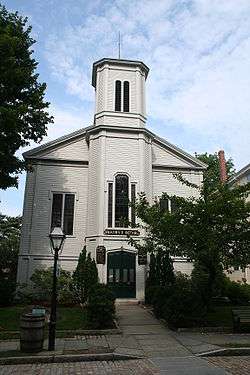Seamen's Bethel
The Seamen's Bethel (or Seaman's Bethel) is a chapel in New Bedford, Massachusetts, United States, located at 15 Johnny Cake Hill.
Seamen's Bethel | |
U.S. National Historic Landmark District Contributing Property | |
 Front elevation, 2006 | |
| Location | New Bedford, Massachusetts |
|---|---|
| Coordinates | 41°38′08″N 70°55′26″W |
| Area | New Bedford Historic District |
| Built | 1832 |
| NRHP reference No. | 66000773 |
| Added to NRHP | 1966 |
History of building
Built by the New Bedford Port Society, it was completed on May 2, 1832. It is a contributing property to the New Bedford Historic District, a National Historic Landmark.
The Seamen's Bethel was specifically constructed for the many sailors who called New Bedford their home port (mostly whalers), who considered it a matter of tradition that one visited the chapel before setting sail.[1]
The bethel was immortalized in Herman Melville's novel Moby-Dick as the "Whaleman's Chapel", in a scene where a nautically themed sermon is given from a bow-shaped pulpit.
The pulpit was a Melville invention, but a replica of the one described in the book was added to the chapel in 1961 by Robert "bob" Baker, boat builder and naval architect from Westport, MA. Other changes were made when the structure was repaired after a fire in 1866. The names of New Bedford whalers killed, and later all area fishermen, are noted on the walls of the bethel. Also noted is the pew that Melville sat in when he visited in 1840.
Moby-Dick
In 1851, Herman Melville published his famous tale of the white whale. In it he wrote:
In this same New Bedford there stands a Whaleman's Chapel, and few are the moody fishermen, shortly bound for the Indian Ocean or Pacific, who fail to make a Sunday visit to the spot.
— Moby-Dick, by Herman Melville
From this point on, the Seamen's Bethel came to be widely seen as a symbol of the whalers, and later as a symbol of their history.
In film
Shots of Seamen's Bethel appear in Down to the Sea in Ships (1922 film). In 1956, John Huston shot a scene from the movie adaptation of Moby-Dick (with Gregory Peck and Orson Welles), in front of the real Seamen's Bethel, but interior shots in the movie were not shot on-location. This revitalized tourism to the area.
New Bedford Whaling National Historical Park
In 1996 the Seamen's Bethel, along with the New Bedford Whaling Museum (located across the street), the historic district and other icons of New Bedford whaling were collectively made into the New Bedford Whaling National Historical Park.
Images
 exterior
exterior interior, with bow shaped pulpit in front
interior, with bow shaped pulpit in front

 Plaques at doorway, as seen in 1968
Plaques at doorway, as seen in 1968
See also
References
- Visitor's Guide Archived 2008-10-08 at the Wayback Machine